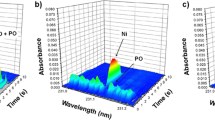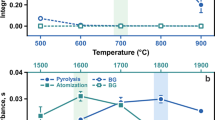Abstract
Dry ashing and wet ashing are two commonly used methods for the preparation of biological materials for trace element analysis by atomic absorption spectrophotometry. In this paper, National Bureau of Standards (NBS) bovine liver was dry ashed at 450°C for 24 h in silica glass (Vycor) or procelain crucibles; the resulting ash was dissolved in either concentrated nitric or hydrochloric acid. Dry ashing efficiency was evaluated by comparing iron, copper, zinc, and manganese concentrations of the samples with the values certified by NBS. Highest recoveries were obtained by dry ashing in silica glass (Vycor) crucibles. Dissolving the resultant ash in either hydrochloric or nitric acids did not significantly alter the results. A comparison between dry and wet ashing shows the latter method to be superior for the preparation of biological tissues for analysis of iron, copper, zinc, and manganese.
Similar content being viewed by others
References
G. D. Christian,Anal. Chem. 41, 24A (1969).
L. Wuyts, J. Smeyers-Verbcke, and D. L. Massart,Clin. Chim. Acta. 72, 405 (1976).
C. A. Johnson,Anal. Chim. Acta 81, 69 (1976).
E. Bonilla,Clin. Chem. 24, 471 (1978).
M. S. Clegg, C. L. Keen, B. Lönnerdal, and L. S. Hurley,Biol. Trace Element Res. 3, 107 (1981).
R. W. Tanahill,Med. J. Aust. 1, 194 (1929).
T. S. Gorsch,The Destruction of Organic Matter, inAnalytical Chemistry Monographs, Vol. 39, R. Belcher and H. Frieser, eds., 1970, p. 20.
C. S. Piper,Soil and Plant Analysis, Interscience, New York, 1944.
G. W. Monier-Williams,Trace Elements in Food, Chapman and Hall, London, 1949.
J. H. High,Analyst 72, 60 (1947).
A. C. Greiner, S. C. Chan, and G. A. Nicholson,Clin. Chim. Acta 61, 335 (1975).
Author information
Authors and Affiliations
Rights and permissions
About this article
Cite this article
Clegg, M.S., Keen, C.L., Lönnerdal, B. et al. Influence of ashing techniques on the analysis of trace elements in biological samples. Biol Trace Elem Res 3, 237–244 (1981). https://doi.org/10.1007/BF02990120
Received:
Accepted:
Issue Date:
DOI: https://doi.org/10.1007/BF02990120
Index Entries
- Ashing techniques, and biotrace element analysis
- analysis, of trace elements in biological samples
- trace element analysis, in biological samples
- dry ashing, in biotrace element analysis
- copper analysis, in biological samples
- iron analysis, in biological samples
- manganese analysis, in biological samples
- zinc analysis, in biological samples




